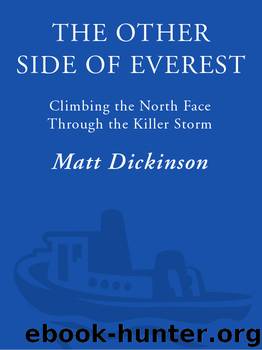The Other Side of Everest by Matt Dickinson

Author:Matt Dickinson [Dickinson, Matt]
Language: eng
Format: epub
ISBN: 978-0-307-55887-9
Publisher: Crown Publishing Group
Published: 2011-08-09T16:00:00+00:00
Our third trek up the East Rongbuk was a very different experience from the first two, with all of us fired up by the adrenaline rush that this time it was for real. The sheer pleasure of being unleashed from the constraints of Base Camp seemed like a catapult shot: I almost felt as if I was walking at sea level, and my mind was clear and untroubled.
After our familiarization climb to 7,000 meters (22,965 feet) at the North Col, our bodies were now able to take these lower altitudes in their stride. Compared with the thinness of the air at the Col, the East Rongbuk, between 6,000 and 6,500 meters (19,684 and 21,325 feet), now seemed to offer rich lungfuls of satisfying oxygen. One month earlier we had been gasping for breath here as we completed the sixteen-kilometer (ten-mile) trek for the first time, taking three days to reach Advance Base Camp. This time we would be a lot faster, reaching ABC in two days.
Although there was no yak traffic on the glacier, there were other distractions. On the lower Rongbuk, we caught glimpses of shy Tibetan deer feeding on the tiny patches of vegetation. When we disturbed them, they ran for the safety of the higher ground, scaling the fragile scree slope so nimbly that not a pebble moved beneath their hooves. On the East Rongbuk we saw no mammals, just a few hardy birds that had arrived with the warmer weather, pecking through the remains of yak fodder for seeds and chaff.
We also saw the Tibetan snowcock, a duck-sized bird that looks like a customized pheasant. Its call is a bizarre cackling sound. Barney told us a tale about a German climber who had shot and eaten one of these birds a few years earlier. Not long after, he was killed while crossing one of the meltwater rivers in full flood. We left the birds well alone.
Around us, the glacier was showing the signs of the spring thaw. Silty meltwater streams were now flowing strongly through the moraine, carving out sinuous routes from the gravel and revealing the milky-white ice beneath. We had to work much harder to keep our feet dry and in some spots only a series of strategically placed boulders enabled us to cross the fast-flowing water.
In places the streams disappeared from sight into sinkholes and ran underground, deep down into the bowels of the glacier. These subterranean streams could sometimes be heard as a rumbling sound beneath our feet, like the sound of a tube train beneath a London street. I looked into one of the sump holes, where the water rushed down into a perfectly round, polished tube of blue ice, large enough to admit a small car. There was the horrifying temptation to jump into it. I wondered what it would be like to be sucked down for a high-speed white-water ride beneath the ice. A bit like a spider getting flushed down a drain, I decided—but colder.
The warmer days of spring had caused another change; now the steep valley sides above the glacier were far less stable.
Download
This site does not store any files on its server. We only index and link to content provided by other sites. Please contact the content providers to delete copyright contents if any and email us, we'll remove relevant links or contents immediately.
China Rich Girlfriend by Kwan Kevin(3896)
The Silk Roads by Peter Frankopan(3763)
Annapurna by Maurice Herzog(2842)
Hot Thai Kitchen by Pailin Chongchitnant(2813)
Full Circle by Michael Palin(2772)
Okonomiyaki: Japanese Comfort Food by Saito Yoshio(2391)
City of Djinns: a year in Delhi by William Dalrymple(2136)
The Ogre by Doug Scott(2115)
Photographic Guide to the Birds of Indonesia by Strange Morten;(2089)
Tokyo by Rob Goss(2018)
Vietnam, Cambodia, Laos & Northern Thailand by Lonely Planet(2014)
Tokyo Geek's Guide: Manga, Anime, Gaming, Cosplay, Toys, Idols & More - The Ultimate Guide to Japan's Otaku Culture by Simone Gianni(1947)
Discover China Travel Guide by Lonely Planet(1866)
Everest the Cruel Way by Joe Tasker(1827)
China (Lonely Planet, 11th Edition)(1798)
Lonely Planet China(1755)
China Travel Guide by Lonely Planet(1741)
Top 10 Dubai and Abu Dhabi by DK Travel(1717)
Iranian Rappers And Persian Porn by Maslin Jamie(1710)
